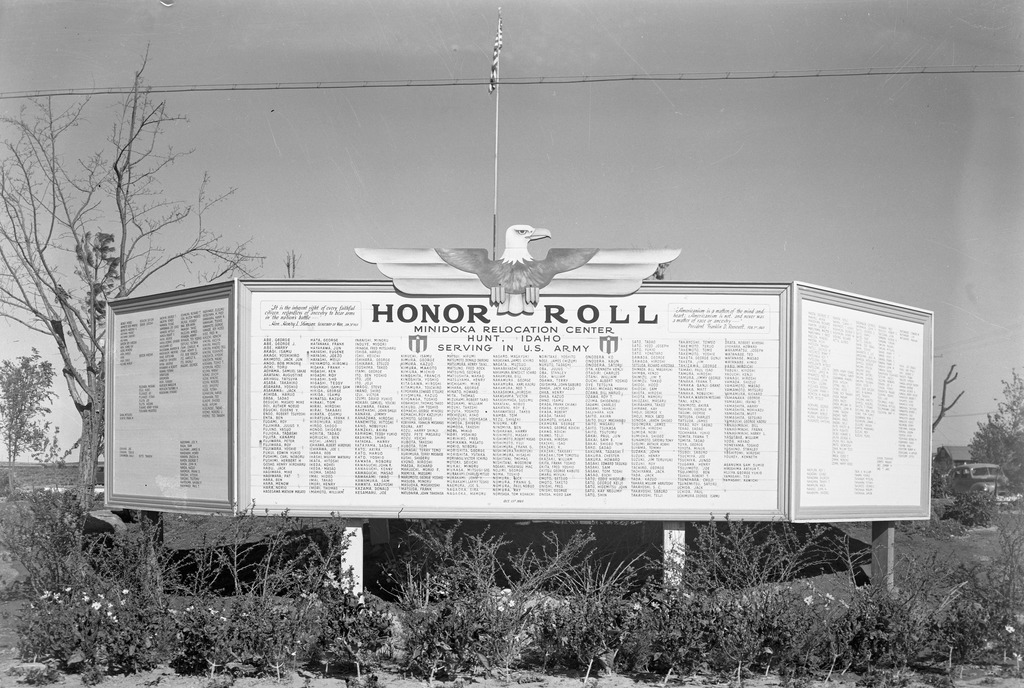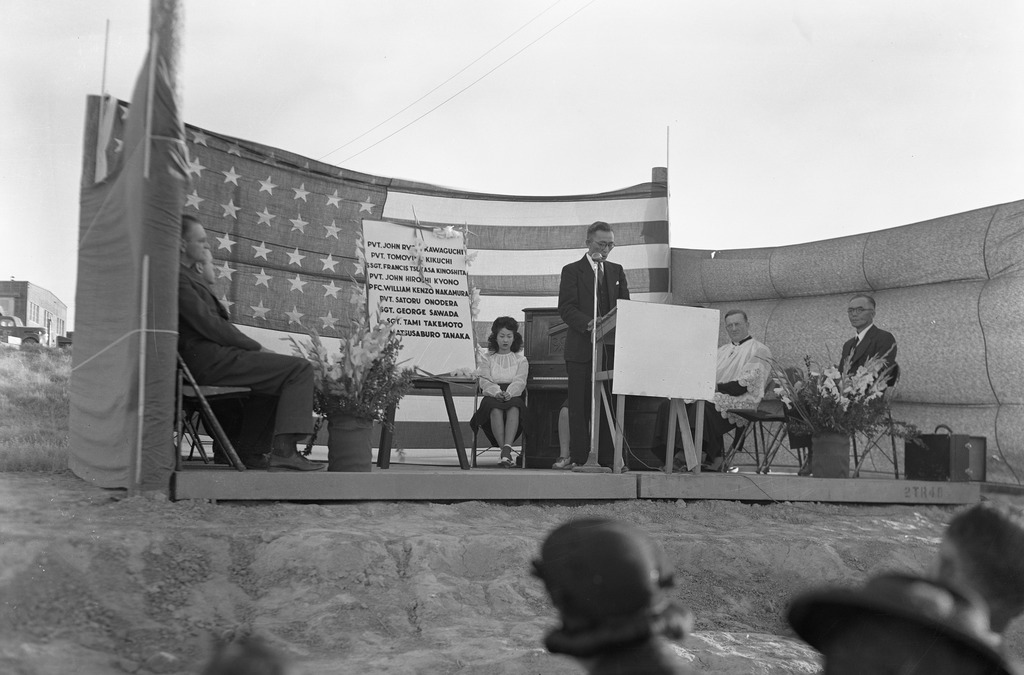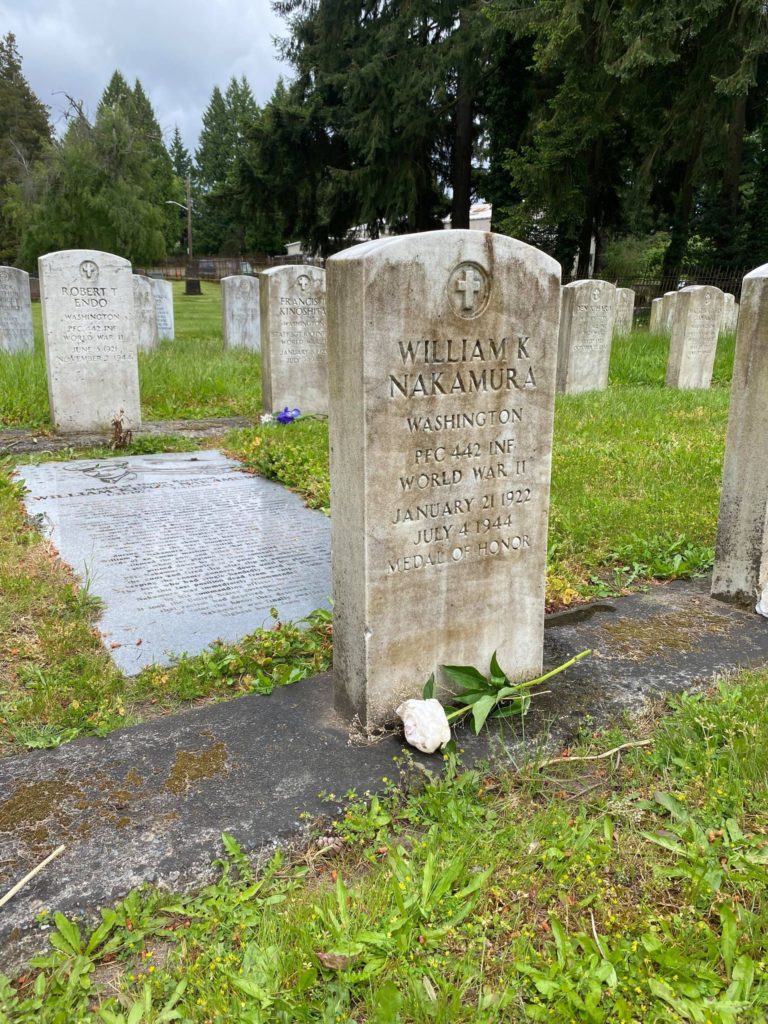Previous post
Next post

For those who have studied the military history of World War II, there should be instant recognition at the mention of the 442nd Regimental Combat Team.
The 442nd, for those who don’t know, was the unit formed solely of Japanese American men and is one of the most highly decorated combat units that served during World War II. Combined with the 100th Infantry Battalion, which was comprised of Japanese Americans from Hawaii, the 442nd saw intense combat in Europe from the summer of 1944 onward, particularly in Italy. The list of Presidential Unit Citations for the 100th and 442nd is long and impressive.
But while these men were fighting, their families were locked up in internment camps back in the United States. Despite the anger, sadness, and frustration that surrounded their incarceration, these young men had volunteered to serve in the Army, often to the dismay of their parents. Remember, they were volunteering to fight for a country that had locked them up because of their race. The history of the Japanese American internment is long and complex, and I have written about it before in different contexts. And when those young men of the 442nd died in combat, there were brokenhearted families left behind, often still in those internment camps.
In my own research on my family’s history, I came across the Densho Digital Repository, which holds National Archives records and photographs for each internment camp. My grandparents actually met each other in Minidoka, the internment camp located outside of Hunt, Idaho. This is where the boy from Seattle met the girl from Portland, and they eventually married in 1945 and remained married until my grandfather’s death in 1996. I have come across images and mentions of my grandparents in digital archives before, so I slowly went through the now-digitally preserved images of Minidoka, wondering what I would find.
What I did find were the heartbreaking images of the families left behind to grieve when their sons died in combat. In the digital archive, there are pages and pages filled with photos of funerals. Some are Buddhist, some are Christian, some are big, some are small. Often, the family is surrounding the service portrait of their soldier, which was probably the last picture they had of him. While each individual portrait of a funeral was hard to look at, knowing the very real grief that must have accompanied each one, the images that really hit me hard were of a joint memorial service that must have been held sometime soon after early July 1944.
Minidoka was very proud of the young men who volunteered to serve in the Army. The camp constructed a “Wall Of Honor” and lettered each name on there.

The 442nd accomplished their objectives, but at a terrible cost. Sometime in the summer of 1944, Minidoka held a camp memorial service for ten young men.

While the photo carries no date, as the negative was scanned into the archives to preserve the image, we do know that the dates of death range between June 27 and July 9, 1944, from their headstones. What we know about what happened during this period of time comes from the account that later became the basis for awarding the Medal of Honor to the fifth name on the list in the above photo. William Kenzo Nakamura, who was killed in combat on July 4, 1944, was first posthumously awarded the Distinguished Service Cross, and then awarded the Medal of Honor in 2000 after a federal review of DSC recipients in the 90’s. Eventually, his name would be put on the federal courthouse in Seattle.
The Medal of Honor citation reads, in part:
During a fierce firefight, Private First Class Nakamura’s platoon became pinned down by enemy machine gun fire from a concealed position. On his own initiative, Private First Class Nakamura crawled 20 yards toward the hostile nest with fire from the enemy machine gun barely missing him. Reaching a point 15 yards from the position, he quickly raised himself to a kneeling position and threw four hand grenades, killing or wounding a least three of the enemy soldiers. The enemy weapon silenced, Private First Class Nakamura crawled back to his platoon, which was able to continue its advance as a result of his couraageous action. Later, his company was ordered to withdraw from the crest of the hill so that a mortar barrage could be placed on the ridge. On his own initiative, Private First Class Nakamura remained in position to cover his comrades’ withdrawl. While moving toward the safety of a wooded draw, his platoon became pinned down by deadly machine gun fire. Crawling to a point from which he could fire on the enemy position, Private First Class Nakamura quickly and accurately fired his weapon to pin down the enemy machine gunners. His platoon was then able to withdraw to safety without further casualties. Private First Class Nakamura was killed during this heroic stand.”
According to accounts, Nakamura was killed by a sniper, and was found still holding his rifle. His family didn’t know any of this, as they sat through a joint memorial service in midsummer 1944. Eventually, five of the men who were honored during this memorial service, who were all killed within twelve days of each other, would all rest near each other at the Veterans Memorial Cemetery at Evergreen Washelli Memorial Park in Seattle. While we don’t know the stories behind their deaths, George Sawada, Francis Kinoshita, Satoru Onodera, and Matsusaburo Tanaka all lie near Nakamura, as do a couple of dozen other members of the 442nd.

And sadly, this would not be the last joint memorial service that Minidoka would hold. I can find records of two more in the digital files (I believe one is mislabeled and the names are not photographed clearly in the picture). It speaks volumes that more than one of these joint memorial services were held within just months of each other, as the third one was likely held in November 1944 (three of these men are also buried at Evergreen Washelli, with their comrades-in-arms).
The utter sadness of the families, and of the crowd gathered to remember these young men, is palpable even through the pictures that have been saved and preserved. The people of Minidoka, caught in that moment in time, were simply grieving. While there was honor in seeing their sons go to fight for their country, there was little pride when a body in a flag-draped casket returned. The men of the 442nd didn’t just give up their lives for their country, they gave up their lives to prove a point, and it was incredibly hard for their families, as Mitchell Maki, now president and CEO of the Go For Broke National Education Center, said in 2019.
Maki says that the notion of incarcerated young Japanese American men voluntarily joining the US military was a mixed blessing, and caused personal turmoil to families already being held in camps.”
“It literally tore families and extended families apart,” Mitchell said. “As half the family would say, ‘Hell no, you’re not gonna go. You’re not gonna go and possibly die fighting for a country that has put us behind barbed wire.’ And then on the other side, there’d be people saying, ‘But if you don’t go, you’re just proving that we are the enemy. You’ve got to go and prove that we’re loyal Americans.’”
And Mitchell Maki says they really did prove it. In spite of facing discrimination at home and in the military overseas, the 442 Regiment is considered the most decorated unit in World War II.”
Thanks to that sacrifice, I can now walk among the graves of the 442nd with my own children, point to the names of men like Nakamura, Kinoshita, Onodera, Sawada, and Tanaka and say “these men died so that YOU would be free. They died so MY father, YOUR grandfather, would not be born in Minidoka. They faced incredible and horrific challenges, and REFUSED to be victims of circumstance. These men lived, they fought, and they died – and we must remember them and their sacrifice.”
On this Memorial Day, I hope that you will remember the men of the 442nd and 100th as well. As the “Greatest Generation” slips away from us and into the arms of history, let us stop to honor those who will never grow old, and gave their all, so that we might be free.
Featured image: The graves of the 442nd at the Veterans Memorial Cemetery at Evergreen Washelli Memorial Park, photo taken May 2017 by the author
[…] post The 442nd: A Legacy Of Valor And Sacrifice appeared first on Victory Girls […]
Thank you for a wonderful article. More importantly, thank you for keeping the memory of the 442nd Regimental Combat Team and the 100th Infantry Battalion alive. Bless them all.
Ditto.
Them and the Windtalkers were pretty incredible.
[…] But Not Sufficient”, also, Twelve Anti-Free Speech Arguments Dismantled Victory Girls: The 442nd RCT – A Legacy Of Valor & Sacrifice Volokh Conspiracy: The Risks When Law School Deans Go Woke Weasel Zippers: Dem Rep Barbara Lee […]
4 Comments